The Genesis Mechanism and Health Risk Assessment of High Boron Water in the Zhaxikang Geothermal Area, South Tibet
Abstract
:1. Introduction
2. Materials and Methods
2.1. Study Area
2.2. Sampling and Analysis
2.3. Data Processing and Analysis
3. Results and Discussion
3.1. Hydrochemical Characteristics
3.2. Evolution Mechanism of Hydrochemical Components
3.2.1. Source of Geothermal Water
3.2.2. Hydrochemical Types and Water–Rock Interaction
3.2.3. Mineral Saturation States and Partial Pressure of CO2 (g)
3.2.4. Source of Chemical Components
3.2.5. Source of B in The Groundwater
3.3. Relationship between the Surface Water and Groundwater
3.4. Health Risk Assessment
3.5. Contamination Model of Drinking Water in Zhaxikang Area
3.6. Prospect of Water Security in Geothermal Development
4. Conclusions
- The geothermal water is characterized by high boron content in the study area, and the chemical type of hot spring water is HCO3-Cl-Na, which is related to the metamorphic CO2 degassing and mixing process in the geothermal area.
- Hydrogen and oxygen isotope, Gibbs diagram, Pearson correlation, and ion correlation were used to explore the evolution mechanism of groundwater quality. Ice melting water, meteoric water, and magmatic water are all sources of geothermal water. The groundwater is an open system, and the major components are controlled by water–rock processes such as silicate mineral dissolution and cation exchange.
- B mainly comes from deep volatiles, cation exchange, and leaching in shallow sediments.
- According to the EWQI results, the water quality of the river gradually deteriorated after flowing through the geothermal area and mixed with geothermal water (with a mix ratio of ~20%). Additionally, there are significant non-carcinogenic health risks if drinking contaminated water, and children are at a higher health risk than adults.
Supplementary Materials
Author Contributions
Funding
Institutional Review Board Statement
Informed Consent Statement
Data Availability Statement
Acknowledgments
Conflicts of Interest
References
- Qu, B.; Zhang, Y.; Kang, S.; Sillanpää, M. Water quality in the Tibetan Plateau: Major ions and trace elements in rivers of the “Water Tower of Asia”. Sci. Total Environ. 2019, 649, 571–581. [Google Scholar] [CrossRef] [PubMed]
- Liao, Z. Thermal Springs and Geothermal Energy in the Qinghai-Tibetan Plateau and the Surroundings; Springer: Singapore, 2018; p. 311. [Google Scholar] [CrossRef]
- Tian, J.; Pang, Z.; Guo, Q.; Wang, Y.; Li, J.; Huang, T.; Kong, Y. Geochemistry of geothermal fluids with implications on the sources of water and heat recharge to the Rekeng high-temperature geothermal system in the Eastern Himalayan Syntax. Geothermics 2018, 74, 92–105. [Google Scholar] [CrossRef]
- Tian, J.; Pang, Z.; Wang, Y.; Guo, Q. Fluid geochemistry of the Cuopu high temperature geothermal system in the eastern Himalayan syntaxis with implication on its genesis. Appl. Geochem. 2019, 110, 104422. [Google Scholar] [CrossRef]
- Wang, Y.; Pang, Z.; Hao, Y.; Fan, Y.; Tian, J.; Li, J. A revised method for heat flux measurement with applications to the fracture-controlled Kangding geothermal system in the Eastern Himalayan Syntaxis. Geothermics 2019, 77, 188–203. [Google Scholar] [CrossRef]
- Wang, Y.; Pang, Z. Heat flux measurements and thermal potential of the Garze geothermal area in the eastern Himalayan Syntaxis. J. Volcanol. Geotherm. Res. 2021, 420, 107407. [Google Scholar] [CrossRef]
- Wang, Y.; Pang, Z. Heat flux in volcanic and geothermal areas: Methods, principles, applications and future directions. Gondwana Res. 2022. [Google Scholar] [CrossRef]
- Zhao, Y.; Han, J.; Zhang, B.; Gong, J. Impact of transferred water on the hydrochemistry and water quality of surface water and groundwater in Baiyangdian Lake, North China. Geosci. Front. 2021, 12, 101086. [Google Scholar] [CrossRef]
- Sharifi, R.; Moore, F.; Keshavarzi, B. Mobility and chemical fate of arsenic and antimony in water and sediments of Sarouq River catchment, Takab geothermal field, northwest Iran. J. Environ. Manag. 2016, 170, 136–144. [Google Scholar] [CrossRef] [PubMed]
- Guo, Q.; Planer-Friedrich, B.; Liu, M.; Yan, K.; Wu, G. Magmatic fluid input explaining the geochemical anomaly of very high arsenic in some southern Tibetan geothermal waters. Chem. Geol. 2019, 513, 32–43. [Google Scholar] [CrossRef]
- Villalba, E.; Tanjal, C.; Borzi, G.; Páez, G.; Carol, E. Geogenic arsenic contamination of wet-meadows associated with a geothermal system in an arid region and its relevance for drinking water. Sci. Total Environ. 2020, 720, 137571. [Google Scholar] [CrossRef]
- Guo, Q.; Wang, Y.; Liu, W. B, As, and F contamination of river water due to wastewater discharge of the Yangbajing geothermal power plant, Tibet, China. Environ. Earth Sci. 2008, 56, 197–205. [Google Scholar] [CrossRef]
- MacDonald, A.; Bonsor, H.C.; Ahmed, K.M.; Burgess, W.G.; Basharat, M.; Calow, R.C.; Dixit, A.; Foster, S.S.D.; Gopal, K.; Lapworth, D.J.; et al. Groundwater quality and depletion in the Indo-Gangetic Basin mapped from in situ observations. Nat. Geosci. 2016, 9, 762–766. [Google Scholar] [CrossRef] [Green Version]
- Wang, Y.; Li, L.; Wen, H.; Hao, Y. Geochemical evidence for the nonexistence of supercritical geothermal fluids at the Yangbajing geothermal field, southern Tibet. J. Hydrol. 2022, 604, 127243. [Google Scholar] [CrossRef]
- Hao, Y.; Pang, Z.; Tian, J.; Wang, Y.; Li, Z.; Li, L.; Xing, L. Origin and evolution of hydrogen-rich gas discharges from a hot spring in the eastern coastal area of China. Chem. Geol. 2020, 538, 119477. [Google Scholar] [CrossRef]
- Tian, Y.; Yu, C.; Zha, X.; Wu, J.; Gao, X.; Feng, C.; Luo, K. Distribution and Potential Health Risks of Arsenic, Selenium, and Fluorine in Natural Waters in Tibet, China. Water 2016, 8, 568. [Google Scholar] [CrossRef] [Green Version]
- Li, C.; Kang, S.; Chen, P.; Zhang, Q.; Mi, J.; Gao, S.; Sillanpää, M. Geothermal spring causes arsenic contamination in river waters of the southern Tibetan Plateau, China. Environ. Earth Sci. 2014, 71, 4143–4148. [Google Scholar] [CrossRef]
- Wang, X.; Dan, Z.; Cui, X.; Zhang, R.; Zhou, S.; Wenga, T.; Yan, B.; Chen, G.; Zhang, Q.; Zhong, L. Contamination, ecological and health risks of trace elements in soil of landfill and geothermal sites in Tibet. Sci. Total Environ. 2020, 715, 136639. [Google Scholar] [CrossRef] [PubMed]
- Liao, Z.; Zhao, P. Geotropics of Yunnan and Tibet: Geothermal Resources and Typical Geothermal Systems; Chinese Academy of Sciences: Beijing, China, 1999. (In Chinese) [Google Scholar]
- Lü, Y.; Zheng, M.; Zhao, P.; Xu, R. Geochemical processes and origin of boron isotopes in geothermal water in the Yunnan-Tibet geothermal zone. Sci. China Earth Sci. 2014, 57, 2934–2944. (In Chinese) [Google Scholar] [CrossRef]
- Voutsa, D.; Dotsika, E.; Kouras, A.; Poutoukis, D.; Kouimtzis, T. Study on distribution and origin of boron in groundwater in the area of Chalkidiki, Northern Greece by employing chemical and isotopic tracers. J. Hazard. Mater. 2009, 172, 1264–1272. [Google Scholar] [CrossRef] [PubMed]
- Ravenscroft, P.; McArthur, J. Mechanism of regional enrichment of groundwater by boron: The examples of Bangladesh and Michigan, USA. Appl. Geochem. 2004, 19, 1413–1430. [Google Scholar] [CrossRef]
- Pennisi, M.; Bianchini, G.; Muti, A.; Kloppmann, W.; Gonfiantini, R. Behaviour of boron and strontium isotopes in groundwater–aquifer interactions in the Cornia Plain (Tuscany, Italy). Appl. Geochem. 2006, 21, 1169–1183. [Google Scholar] [CrossRef]
- Zango, M.S.; Sunkari, E.D.; Abu, M.; Lermi, A. Hydrogeochemical controls and human health risk assessment of groundwater fluoride and boron in the semi-arid North East region of Ghana. J. Geochem. Explor. 2019, 207, 106363. [Google Scholar] [CrossRef]
- Liu, M.; Guo, Q.; Luo, L.; He, T. Environmental impacts of geothermal waters with extremely high boron concentrations: Insight from a case study in Tibet, China. J. Volcanol. Geotherm. Res. 2020, 397, 106887. [Google Scholar] [CrossRef]
- Nigro, A.; Sappa, G.; Barbieri, M. Boron isotopes in groundwater: Evidence from contamination and interaction with terrigenous–evaporitic sequence, east-central Italy. Geochem. Explor. Environ. Anal. 2018, 18, 343–350. [Google Scholar] [CrossRef]
- Vengosh, A. The isotopic composition of anthropogenic boron and its potential impact on the environment. Biol. Trace Element Res. 1998, 66, 145–151. [Google Scholar] [CrossRef] [PubMed]
- WHO. Guidelines for Drinking-Water Quality: Incorporating First Addendum, World Health Organization. 2017. Available online: https://www.who.int/publications-detail-redirect/9789241549950 (accessed on 8 July 2022).
- Tong, W.; Liao, Z.; Liu, S. Thermal Springs in Tibet; Science Press: Beijing, China, 2000. [Google Scholar]
- Duan, J.; Tang, J.; Lin, B. Zinc and lead isotope signatures of the Zhaxikang PbZn deposit, South Tibet: Implications for the source of the ore-forming metals. Ore Geol. Rev. 2016, 78, 58–68. [Google Scholar] [CrossRef]
- Qing, C.; Ding, J.; Li, G.; Zhou, Q.; Lai, Y. Element Distribution of the Surrounding Rock of Zhaxikang Deposit in Longzi Country, Tibet. Metal Mine 2014, 43, 97–100. (In Chinese) [Google Scholar]
- Wang, D.; Sun, X.; Zheng, Y.; Wu, S.; Xia, S.; Chang, H.; Yu, M. Two pulses of mineralization and genesis of the Zhaxikang Sb–Pb–Zn–Ag deposit in southern Tibet: Constraints from Fe–Zn isotopes. Ore Geol. Rev. 2017, 84, 347–363. [Google Scholar] [CrossRef]
- Gu, H.; Ni, H.; Wang, Y.; Liu, Y.; Li, D.; Zhang, Z. Hydrogeochemical Characteristics and Impact of Arsenic Released from a Gold Deposit in Tibet. Mine Water Environ. 2020, 39, 746–757. [Google Scholar] [CrossRef]
- Wang, Y.; Gu, H.; Li, D.; Lyu, M.; Lu, L.; Zuo, Y.; Song, R. Hydrochemical characteristics and genesis analysis of geothermal fluid in the Zhaxikang geothermal field in Cuona County, southern Tibet. Environ. Earth Sci. 2021, 80, 415. [Google Scholar] [CrossRef]
- Bhutiani, R.; Kulkarni, D.B.; Khanna, D.R.; Gautam, A. Water Quality, Pollution Source Apportionment and Health Risk Assessment of Heavy Metals in Groundwater of an Industrial Area in North India. Expo. Health 2016, 8, 3–18. [Google Scholar] [CrossRef]
- Wongsasuluk, P.; Chotpantarat, S.; Siriwong, W.; Robson, M. Heavy metal contamination and human health risk assessment in drinking water from shallow groundwater wells in an agricultural area in Ubon Ratchathani province, Thailand. Environ. Geochem. Health 2014, 36, 169–182. [Google Scholar] [CrossRef] [PubMed]
- Guo, Q.; Liu, M.; Li, J.; Zhang, X.; Guo, W.; Wang, Y. Fluid geochemical constraints on the heat source and reservoir temperature of the Banglazhang hydrothermal system, Yunnan-Tibet Geothermal Province, China. J. Geochem. Explor. 2017, 172, 109–119. [Google Scholar] [CrossRef]
- Domenico, P.A.; Schwartz, F.W. Physical and Chemical Hydrogeology; Wiley: New York, NY, USA, 1998. [Google Scholar]
- Adimalla, N. Groundwater quality delineation based on fuzzy comprehensive assessment method (FCAM): A case study. Arab. J. Geosci. 2020, 13, 1256. [Google Scholar] [CrossRef]
- Chen, F.; Yao, L.; Mei, G.; Shang, Y.; Xiong, F.; Ding, Z. Groundwater Quality and Potential Human Health Risk Assessment for Drinking and Irrigation Purposes: A Case Study in the Semiarid Region of North China. Water 2021, 13, 783. [Google Scholar] [CrossRef]
- USEPA. User’s Guide: Human Health Risk Assessment; United States Environmental Protection Agency: Washington, DC, USA, 2008.
- Parkhurst, D.L.; Appelo, C.A.J. Description of Input and Examples for PHREEQC Version 3—A Computer Program for Speciation, Batch-reaction, One-dimensional Transport, and Inverse Geochemical Calculations. In Techniques and Methods; U.S. Geological Survey: Reston, VA, USA, 2013. [Google Scholar]
- Guo, Q.; Wang, Y.; Liu, W. O, H, and Sr isotope evidences of mixing processes in two geothermal fluid reservoirs at Yangbajing, Tibet, China. Environ. Earth Sci. 2010, 59, 1589–1597. [Google Scholar] [CrossRef]
- Giggenbach, W. Isotopic shifts in waters from geothermal and volcanic systems along convergent plate boundaries and their origin. Earth Planet. Sci. Lett. 1992, 113, 495–510. [Google Scholar] [CrossRef]
- Hudson-Edwards, K.A.; Archer, J. Geochemistry of As-, F- and B-bearing waters in and around San Antonio de los Cobres, Argentina, and implications for drinking and irrigation water quality. J. Geochem. Explor. 2012, 112, 276–284. [Google Scholar] [CrossRef] [Green Version]
- Lu, L.; Pang, Z.; Kong, Y.; Guo, Q.; Wang, Y.; Xu, C.; Gu, W.; Zhou, L.; Yu, D. Geochemical and isotopic evidence on the recharge and circulation of geothermal water in the Tangshan Geothermal System near Nanjing, China: Implications for sustainable development. Appl. Hydrogeol. 2018, 26, 1705–1719. [Google Scholar] [CrossRef]
- Craig, H. Isotopic Variations in Meteoric Waters. Science 1961, 133, 1833–1834. [Google Scholar] [CrossRef]
- Wen, R.; Tian, L.; Weng, Y.; Liu, Z.; Zhao, Z. The altitude effect of δ 18O in precipitation and river water in the Southern Himalayas. Chin. Sci. Bull. 2012, 57, 1693–1698. [Google Scholar] [CrossRef] [Green Version]
- Shah, B.; Kansara, B.; Shankar, J.; Soni, M.; Bhimjiyani, P.; Bhanushali, T.; Shah, M.; Sircar, A. Reckoning of water quality for irrigation and drinking purposes in the konkan geothermal provinces, Maharashtra, India. Groundw. Sustain. Dev. 2019, 9, 100247. [Google Scholar] [CrossRef]
- Gibbs, R.J. Mechanisms Controlling World Water Chemistry. Science 1970, 170, 1088–1090. [Google Scholar] [CrossRef]
- Gou, Q.Q.; Han, Z.W.; Wang, G.H. Research Progress on Soil Salinization in Arid Irrigated Area of Northwestern China. Chin. Agric. Sci. Bull. 2011, 29, 246–250. (In Chinese) [Google Scholar]
- Bennett, G.; Van Reybrouck, J.; Shemsanga, C.; Kisaka, M.; Tomašek, I.; Fontijn, K.; Kervyn, M.; Walraevens, K. Identification of low fluoride areas using conceptual groundwater flow model and hydrogeochemical system analysis in the aquifer system on the flanks of an active volcano: Mount Meru, Northern Tanzania. Sci. Total Environ. 2021, 814, 152682. [Google Scholar] [CrossRef] [PubMed]
- Bretzler, A.; Osenbrück, K.; Gloaguen, R.; Ruprecht, J.S.; Kebede, S.; Stadler, S. Groundwater origin and flow dynamics in active rift systems—A multi-isotope approach in the Main Ethiopian Rift. J. Hydrol. 2011, 402, 274–289. [Google Scholar] [CrossRef]
- Farooqi, A.; Masuda, H.; Firdous, N. Toxic fluoride and arsenic contaminated groundwater in the Lahore and Kasur districts, Punjab, Pakistan and possible contaminant sources. Environ. Pollut. 2007, 145, 839–849. [Google Scholar] [CrossRef] [PubMed]
- Zhang, Y.; Dai, Y.; Wang, Y.; Huang, X.; Xiao, Y.; Pei, Q. Hydrochemistry, quality and potential health risk appraisal of nitrate enriched groundwater in the Nanchong area, southwestern China. Sci. Total Environ. 2021, 784, 147186. [Google Scholar] [CrossRef] [PubMed]
- Gaillardet, J.; Dupré, B.; Louvat, P.; Allègre, C. Global silicate weathering and CO2 consumption rates deduced from the chemistry of large rivers. Chem. Geol. 1999, 159, 3–30. [Google Scholar] [CrossRef]
- Palmucci, W.; Rusi, S. Boron-rich groundwater in Central Eastern Italy: A hydrogeochemical and statistical approach to define origin and distribution. Environ. Earth Sci. 2014, 72, 5139–5157. [Google Scholar] [CrossRef]
- Gemici, U.; Tarcan, G. Distribution of boron in thermal waters of western Anatolia, Turkey, and examples of their environmental impacts. Environ. Earth Sci. 2002, 43, 87–98. [Google Scholar] [CrossRef]
- Liu, M.; Guo, Q.; Wu, G.; Guo, W.; She, W.; Yan, W. Boron geochemistry of the geothermal waters from two typical hydrothermal systems in Southern Tibet (China): Daggyai and Quzhuomu. Geothermics 2019, 82, 190–202. [Google Scholar] [CrossRef]
- Das, S.; Nag, S.K. Application of multivariate statistical analysis concepts for assessment of hydrogeochemistry of groundwater—A study in Suri I and II blocks of Birbhum District, West Bengal, India. Appl. Water Sci. 2015, 7, 873–888. [Google Scholar] [CrossRef] [Green Version]
- Karro, E.; Uppin, M. The occurrence and hydrochemistry of fluoride and boron in carbonate aquifer system, central and western Estonia. Environ. Monit. Assess. 2013, 185, 3735–3748. [Google Scholar] [CrossRef]
- Murray, F. A Human Health Risk Assessment of Boron (Boric Acid and Borax) in Drinking Water. Regul. Toxicol. Pharmacol. 1995, 22, 221–230. [Google Scholar] [CrossRef] [PubMed]
- Zhang, X.; Li, X.; Budu; Liu, Y. Analysis on sanitary monitoring of drinking water quality in Linzhi region of Tibet in 2011. Tibet. J. Med. 2013, 1, 62–64. (In Chinese) [Google Scholar]
- Adimalla, N.; Qian, H. Groundwater quality evaluation using water quality index (WQI) for drinking purposes and human health risk (HHR) assessment in an agricultural region of Nanganur, south India. Ecotoxicol. Environ. Saf. 2019, 176, 153–161. [Google Scholar] [CrossRef] [PubMed]
- Durowoju, O.S.; Ekosse, G.-I.E.; Odiyo, J.O. Occurrence and Health-Risk Assessment of Trace Metals in Geothermal Springs within Soutpansberg, Limpopo Province, South Africa. Int. J. Environ. Res. Public Health 2020, 17, 4438. [Google Scholar] [CrossRef] [PubMed]
- Ravikumar, P.; Mehmood, M.A.; Somashekar, R.K. Water quality index to determine the surface water quality of Sankey tank and Mallathahalli lake, Bangalore urban district, Karnataka, India. Appl. Water Sci. 2013, 3, 247–261. [Google Scholar] [CrossRef] [Green Version]
- Guo, Q.; Pang, Z.; Wang, Y.; Tian, J. Fluid geochemistry and geothermometry applications of the Kangding high-temperature geothermal system in eastern Himalayas. Appl. Geochem. 2017, 81, 63–75. [Google Scholar] [CrossRef]
- Luo, J.; Pang, Z.; Kong, Y.; Wang, Y. Geothermal potential evaluation and development prioritization based on geochemistry of geothermal waters from Kangding area, western Sichuan, China. Environ. Earth Sci. 2017, 76, 343. [Google Scholar] [CrossRef]
- Dong, B.; Dong, S.; Wang, Y.; Wen, F.; Yu, C.; Zhou, J.; Song, R. Detecting Geothermal Resources in a Plateau Area: Constraints From Land Surface Temperature Characteristics Using Landsat 8 Data. Front. Earth Sci. 2022, 10, 785900. [Google Scholar] [CrossRef]
- Hu, J.; Tian, Y.; Li, Z.; Jiang, G.; Zuo, Y.; Zhang, C.; Wang, Y.; Wang, Y.; Hu, S. Geothermo Tool: An open-source software for basic geothermal calculations and plots. Geothermics 2022, 106, 102551. [Google Scholar] [CrossRef]
- Li, P.; Qian, H.; Wu, J. Groundwater Quality Assessment Based on Improved Water Quality Index in Pengyang County, Ningxia, Northwest China. E-J. Chem. 2010, 7, 451304. [Google Scholar] [CrossRef] [Green Version]
- Ugran, V. Groundwater fluoride contamination and its possible health implications in Indi taluk of Vijayapura District (Karnataka State), India. Environ. Geochem. Health 2017, 39, 1017–1029. [Google Scholar] [CrossRef] [PubMed]
- Sathe, S.; Mahanta, C.; Subbiah, S. Hydrogeochemical Evaluation of Intermittent Alluvial Aquifers Controlling Arsenic and Fluoride Contamination and Corresponding Health Risk Assessment. Expo. Health 2021, 13, 661–680. [Google Scholar] [CrossRef]
- Zhang, Y.; Wu, J.; Xu, B. Human health risk assessment of groundwater nitrogen pollution in Jinghui canal irrigation area of the loess region, northwest China. Environ. Earth Sci. 2018, 77, 273. [Google Scholar] [CrossRef]
- USEPA. Human Health Evaluation Manual, Supplemental Guidance: Update of Standard Default Exposure Factors; United States Environmental Protection Agency: Washington, DC, USA, 2014.
- USEPA. Integrated Risk Information System; United States Environmental Protection Agency: Washington, DC, USA, 2012.
- Li, P.; Tian, R.; Liu, R. Solute Geochemistry and Multivariate Analysis of Water Quality in the Guohua Phosphorite Mine, Guizhou Province, China. Expo. Health 2019, 11, 81–94. [Google Scholar] [CrossRef]
- Wu, J.; Sun, Z. Evaluation of Shallow Groundwater Contamination and Associated Human Health Risk in an Alluvial Plain Impacted by Agricultural and Industrial Activities, Mid-west China. Expo. Health 2016, 8, 311–329. [Google Scholar] [CrossRef]
- Edet, A.; Worden, R. Monitoring of the physical parameters and evaluation of the chemical composition of river and groundwater in Calabar (Southeastern Nigeria). Environ. Monit. Assess. 2009, 157, 243–258. [Google Scholar] [CrossRef] [PubMed]
- Davis, S.; Whittemore, D.; Fabryka-Martin, J. Uses of Chloride/Bromide Ratios in Studies of Potable Water. Ground Water 1998, 36, 338–350. [Google Scholar] [CrossRef]
- Rautio, A.; Korkka-Niemi, K. Chemical and isotopic tracers indicating groundwater/surface-water interaction within a boreal lake catchment in Finland. Hydrogeol. J. 2015, 23, 687–705. [Google Scholar] [CrossRef]
- Dun, Y.; Tang, C.; Shen, Y. Identifying interactions between river water and groundwater in the North China Plain using multiple tracers. Environ. Earth Sci. 2013, 72, 99–110. [Google Scholar] [CrossRef]
- Lamontagne, S. River infiltration to a subtropical alluvial aquifer inferred using multiple environmental tracers. Water Resour. Res. 2015, 51, 4532–4549. [Google Scholar] [CrossRef] [Green Version]
- Crandall, C.; Katz, B.; Hirten, J. Hydrochemical evidence for mixing of river water and groundwater during high-flow conditions, lower Suwannee River basin, Florida, USA. Hydrogeol. J. 1999, 7, 454–467. [Google Scholar] [CrossRef]
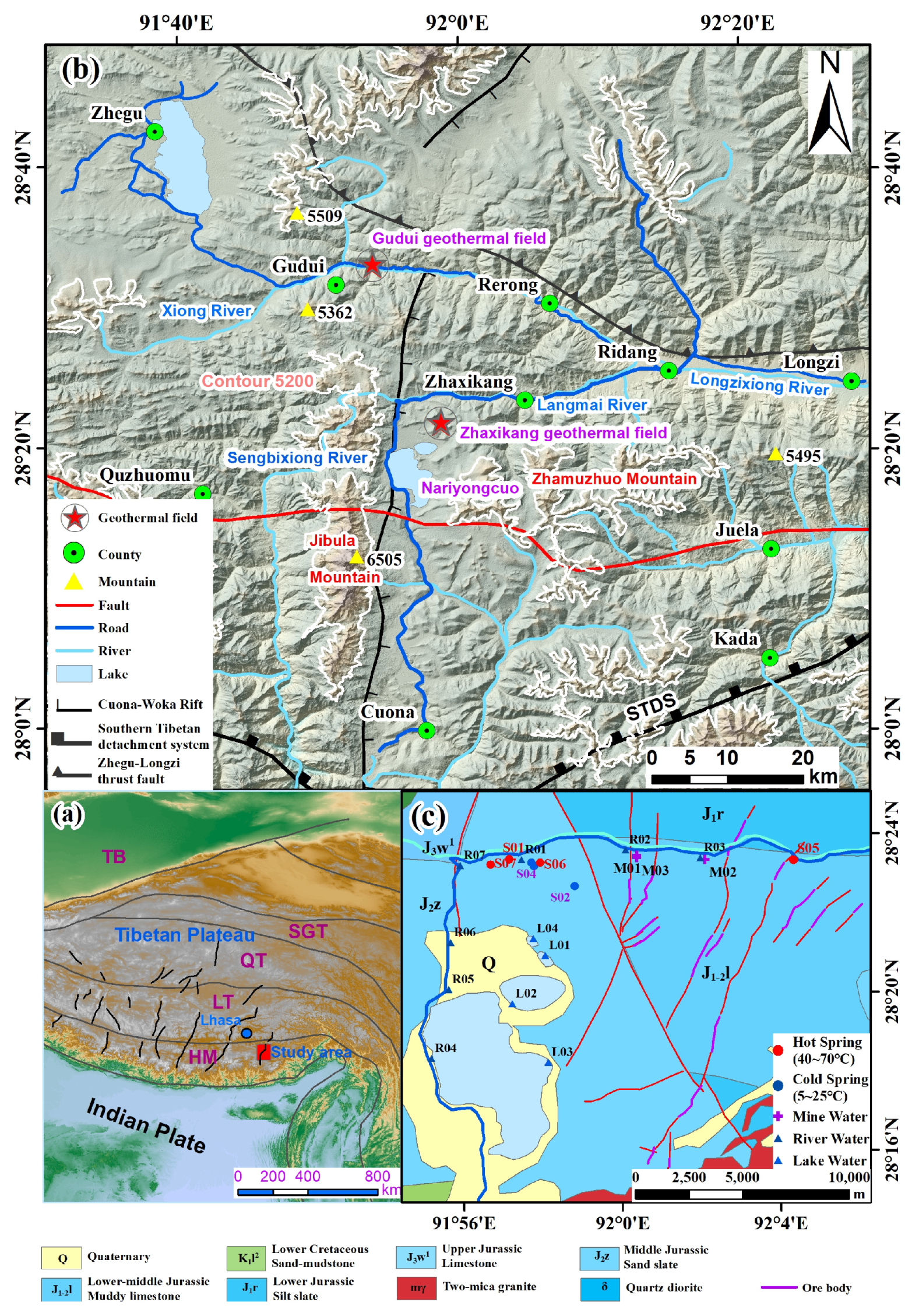
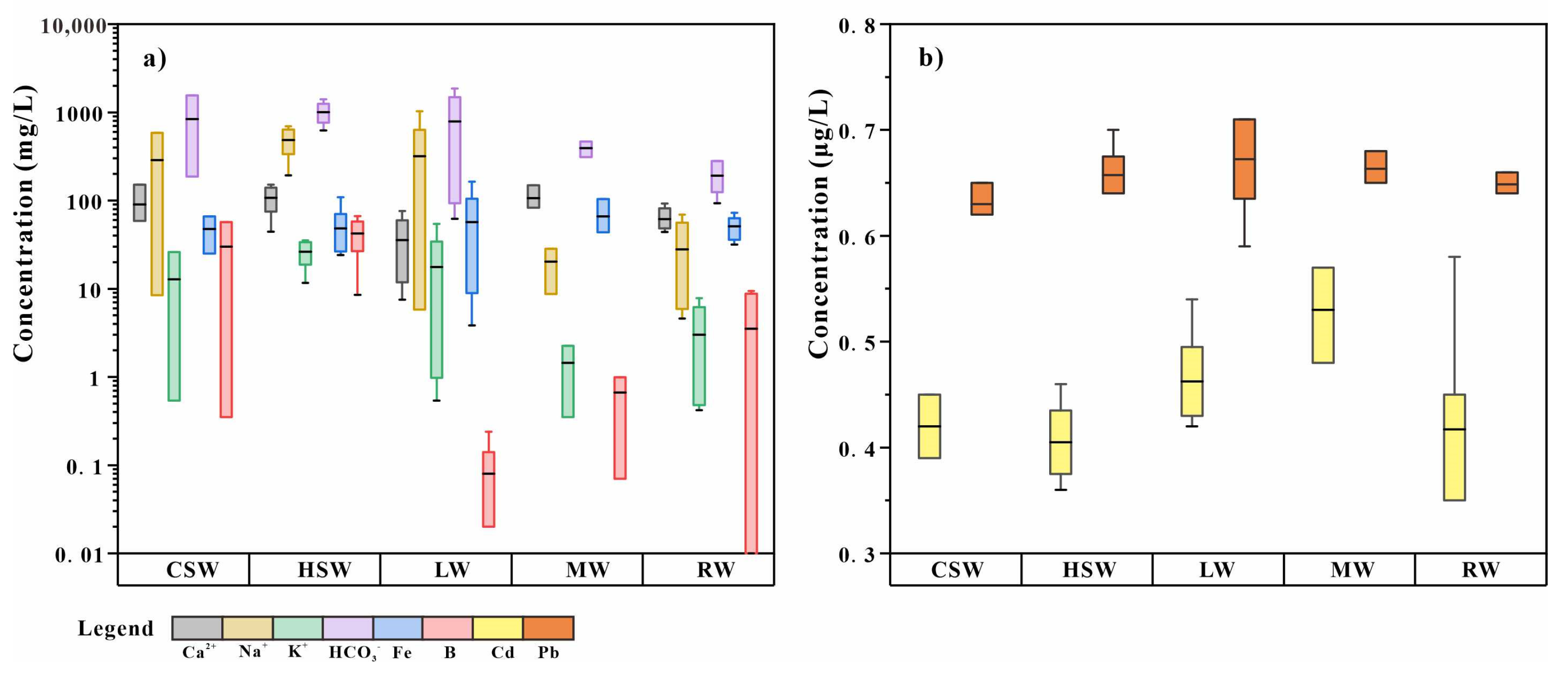
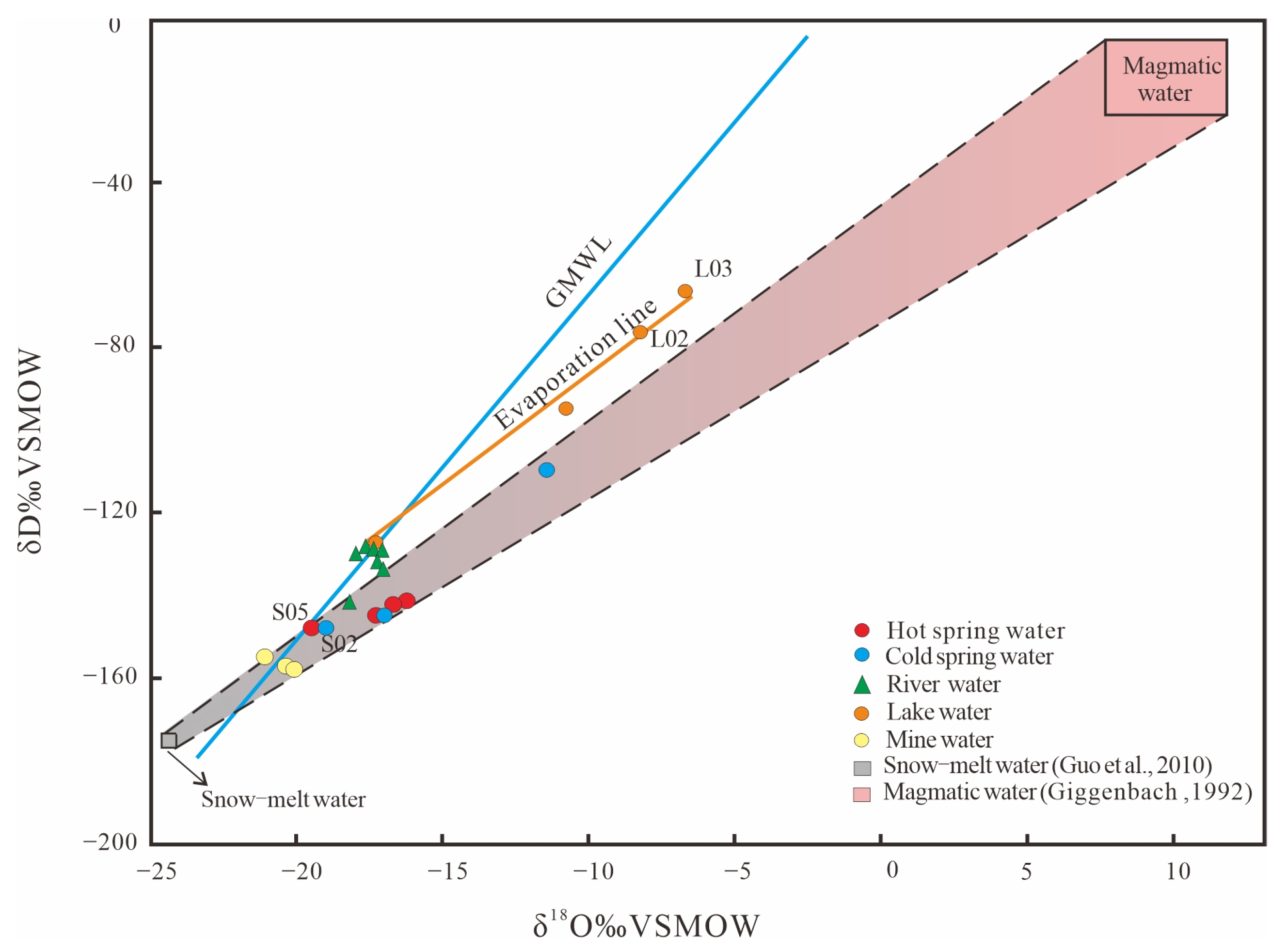


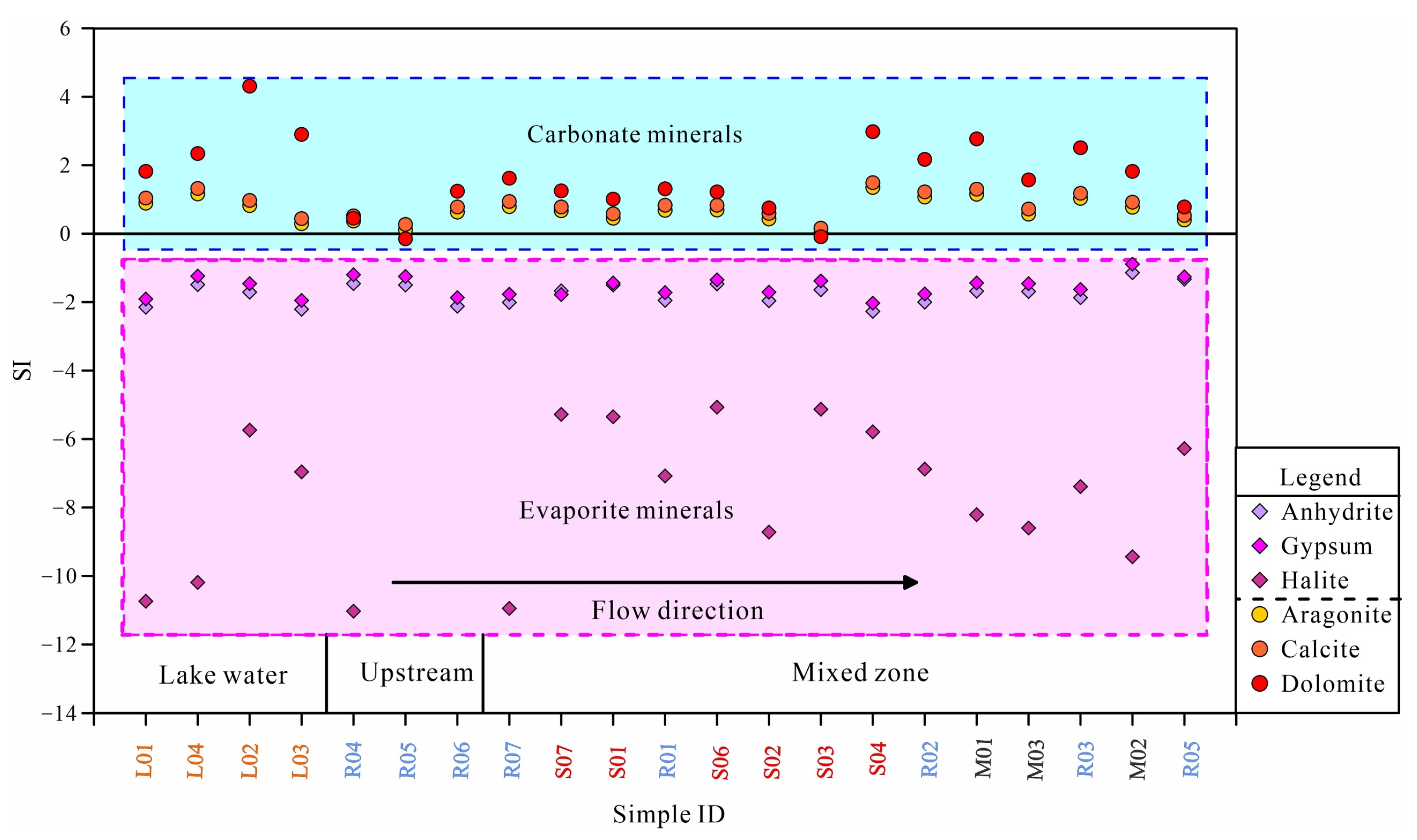
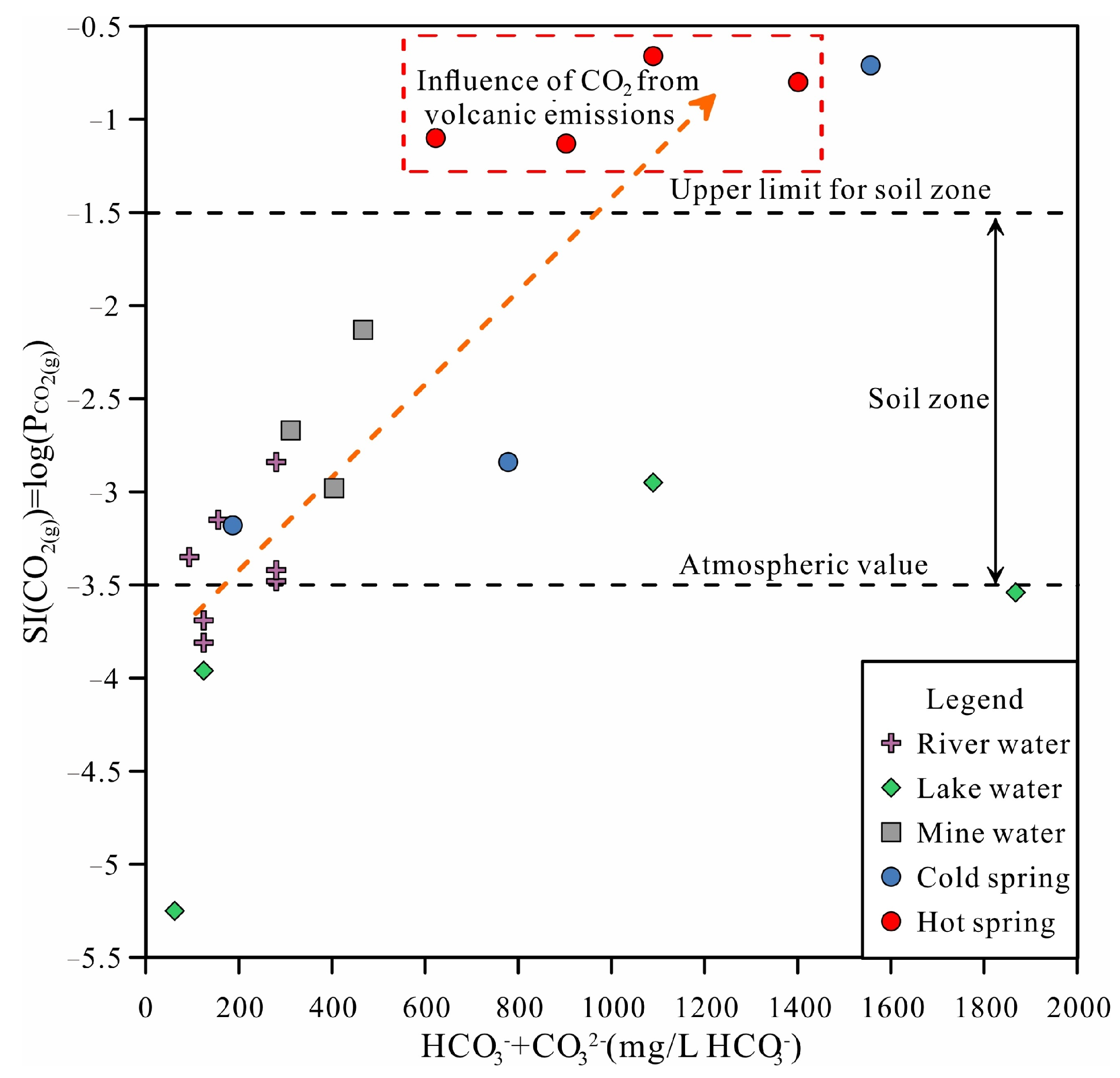
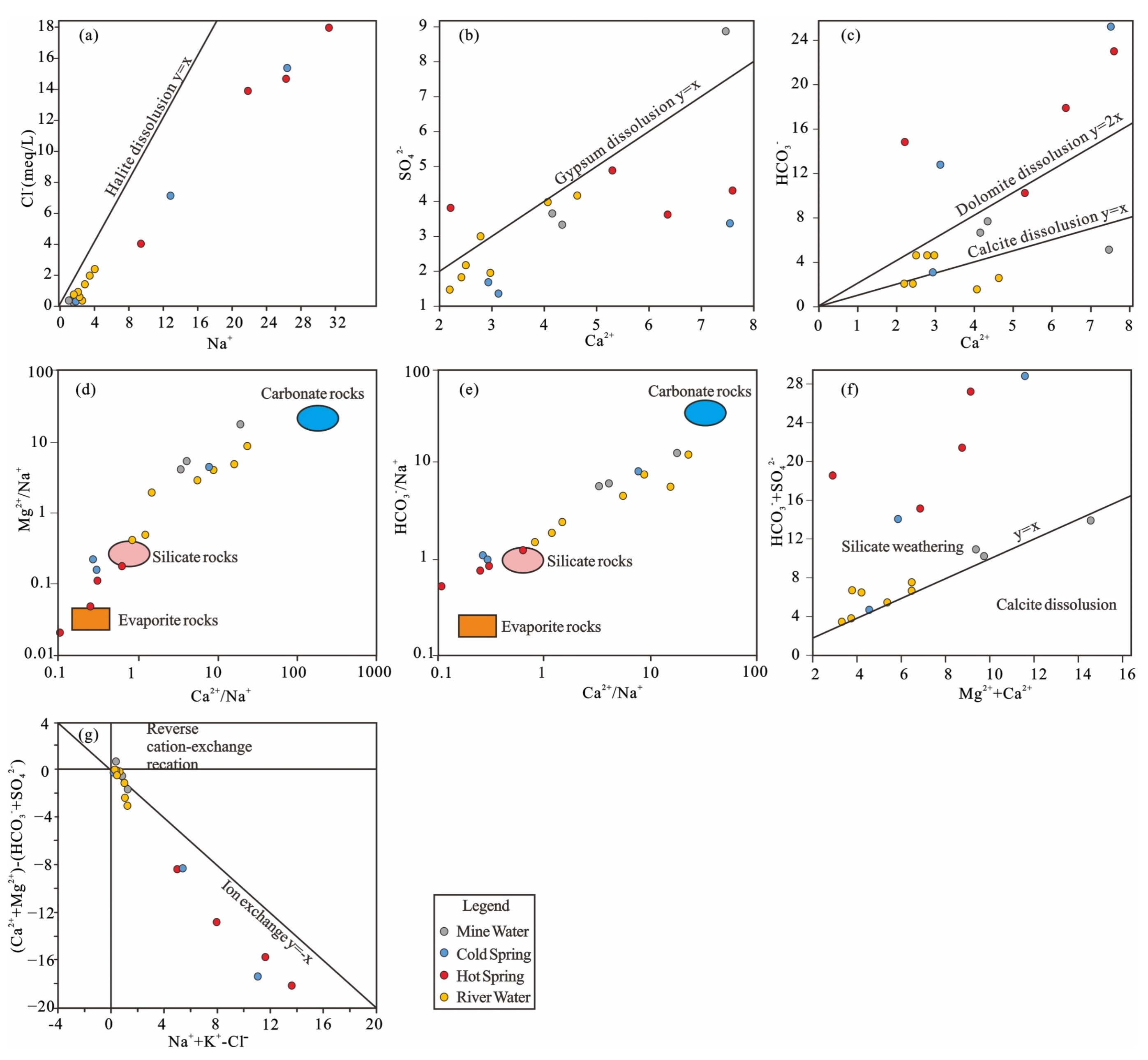

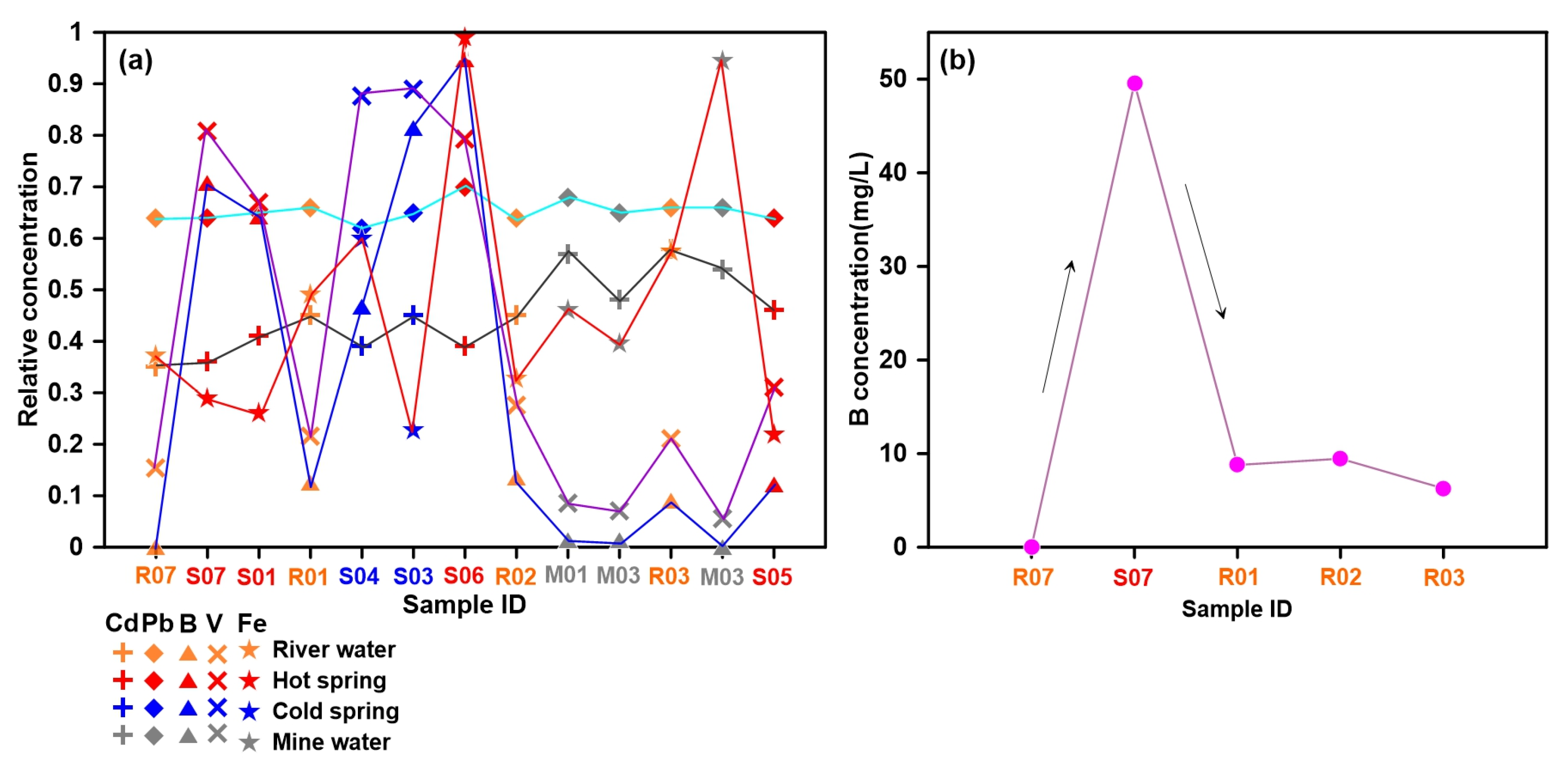
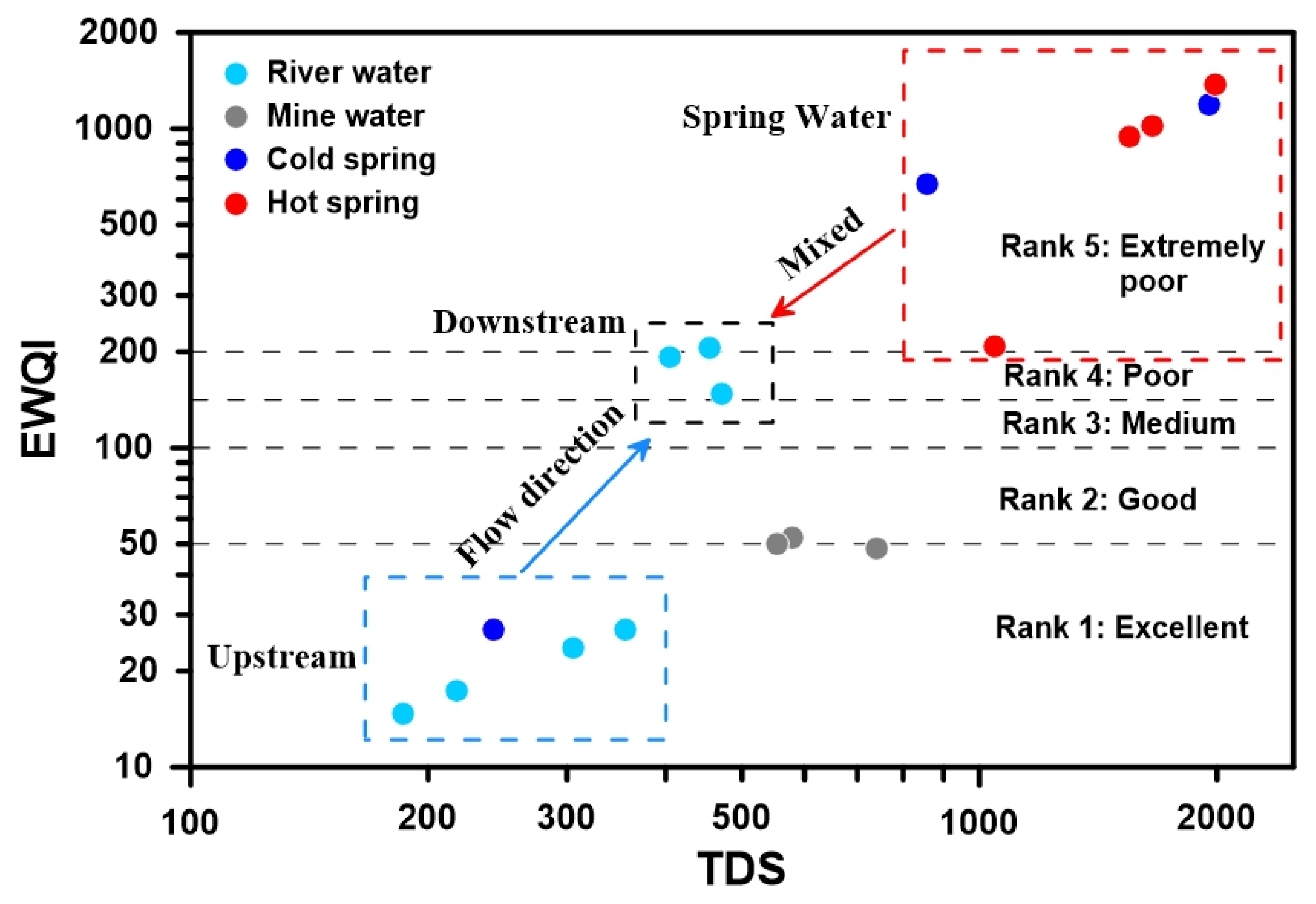

| Sample ID | Water Type | pH | Temp [°C] | EC [μS/cm] | ORP [mV] | TDS [mg/L] | δ2H [‰] | δ18O [‰] |
|---|---|---|---|---|---|---|---|---|
| R01 | rw | 8.22 | 19.65 | 559 | 21.5 | 404.5 | −131 | −17.2 |
| R02 | rw | 8.79 | 17.84 | 604.5 | 20 | 455.5 | −133 | −17.1 |
| R03 | rw | 8.73 | 16.94 | 613 | 31.8 | 470.9 | −141 | −18.2 |
| R04 | rw | 8.2 | 5.55 | 343 | 27.8 | 354.8 | −129 | −17.8 |
| R05 | rw | 8.19 | 6.33 | 302.9 | 35 | 305.9 | −128 | −17.6 |
| R06 | rw | 8.68 | 15.08 | 232.4 | 25.6 | 186.3 | −128 | −17.4 |
| R07 | rw | 8.8 | 17.17 | 284.6 | 12.6 | 217.6 | −129 | −17.2 |
| L01 | lw | 8.94 | 18.34 | 281.1 | 23.2 | 209.3 | −128 | −17.4 |
| L02 | lw | 9.24 | 14.89 | 8944.7 | 23.2 | 7206 | −76.7 | −8.26 |
| L03 | lw | 8.74 | 10.66 | 2630.7 | 25.4 | 2356 | −67 | −6.59 |
| L04 | lw | 9.65 | 16.1 | 422.6 | 29.8 | 331.2 | −99.3 | −11.4 |
| M01 | mw | 8.48 | 19.2 | 793.2 | 40.3 | 580.1 | −157 | −20.1 |
| M02 | mw | 8.05 | 15.65 | 935.6 | −41 | 740.4 | −154 | −21.1 |
| M03 | mw | 7.74 | 21.4 | 718.4 | 38.7 | 554 | −156 | −20.3 |
| S01 | hsw | 6.82 | 50.2 | 3523.1 | −10.6 | 1547 | −144 | −17.3 |
| S02 | csw | 8.32 | 6.53 | 240.5 | 23.3 | 241.5 | −147 | −19 |
| S03 | csw | 6.75 | 8.17 | 2035.4 | 15.6 | 1950 | −144 | −17 |
| S04 | csw | 8.6 | 18.35 | 1152 | 14.5 | 857.7 | −109 | −11.5 |
| S05 | hsw | 7.03 | 49.97 | 2372.1 | −19.6 | 1044 | −147 | −19.5 |
| S06 | hsw | 7.01 | 43.33 | 4138.7 | −17.7 | 1992 | −142 | −16.3 |
| S07 | hsw | 7.35 | 69.51 | 4698 | −262.5 | 1653 | −142 | −16.6 |
| Snow-melt water a | - | - | - | - | - | −175.0 | −24.5 | |
| Magmatic water b | - | - | - | - | - | −20 ± 10 | 10 ± 2 |
| Parameters | WHO Standards | Hot Spring Water (n = 4) | Cold Spring Water (n = 3) | Lake Water (n = 4) | Mine Water (n = 3) | River Water (n = 7) | ||||||||||
|---|---|---|---|---|---|---|---|---|---|---|---|---|---|---|---|---|
| Min | Max | Mean | Min | Max | Mean | Min | Max | Mean | Min | Max | Mean | Min | Max | Mean | ||
| K+ | ≤200 | 11.68 | 35.40 | 26.31 | 0.54 | 26.10 | 12.75 | 0.54 | 54.23 | 17.65 | 0.35 | 2.25 | 1.45 | 0.42 | 7.80 | 3.02 |
| Na+ | ≤200 | 193.00 | 695.00 | 486.25 | 8.43 | 584.00 | 288.14 | 5.73 | 1028.00 | 318.15 | 8.75 | 28.30 | 20.25 | 4.58 | 69.50 | 27.87 |
| Ca2+ | ≤200 | 44.20 | 151.90 | 107.30 | 58.61 | 150.90 | 90.66 | 7.51 | 76.31 | 35.76 | 83.04 | 149.30 | 106.39 | 43.89 | 92.58 | 61.60 |
| Mg2+ | ≤150 | 7.43 | 28.07 | 17.77 | 18.81 | 47.85 | 32.91 | 13.08 | 2123.00 | 671.71 | 59.71 | 84.46 | 70.19 | 12.78 | 43.63 | 19.54 |
| Cl− | ≤250 | 128.00 | 621.00 | 433.55 | 7.60 | 530.80 | 258.83 | 0.11 | 103.50 | 31.35 | 1.64 | 10.05 | 5.07 | 0.00 | 69.83 | 22.86 |
| SO42− | ≤250 | 175.30 | 235.90 | 201.00 | 66.74 | 163.20 | 104.09 | 69.61 | 8524.00 | 2654.55 | 161.40 | 427.20 | 255.13 | 72.15 | 201.40 | 128.77 |
| HCO3− | ≤120 | 622.62 | 1401.00 | 1004.00 | 186.79 | 1556.54 | 840.53 | 62.26 | 1867.85 | 786.05 | 311.31 | 466.96 | 394.32 | 93.39 | 280.18 | 191.23 |
| NO3− | ≤20 | 0.00 | 5.82 | 1.55 | 0.19 | 23.98 | 9.93 | 0.00 | 0.70 | 0.23 | 0.00 | 1.04 | 0.45 | 0.00 | 1.72 | 0.49 |
| B | <0.5 | 8.55 | 66.36 | 42.36 | 0.35 | 57.02 | 30.02 | 0.02 | 0.24 | 0.08 | 0.07 | 0.99 | 0.66 | 0.01 | 9.46 | 3.52 |
| SiO2 | - | 54.54 | 105.50 | 72.23 | 7.96 | 24.82 | 13.96 | 1.51 | 5.88 | 3.12 | 13.09 | 25.64 | 19.87 | 4.47 | 20.44 | 12.22 |
| V (μg/L) | - | 1.55 | 4.04 | 3.23 | 0.62 | 4.45 | 3.35 | 0.95 | 2.52 | 1.71 | 0.28 | 0.43 | 0.35 | 0.38 | 1.46 | 0.93 |
| As (μg/L) | ≤50 | 0.03 | 6.96 | 2.86 | 0.03 | 5.92 | 1.99 | 0.03 | 126.68 | 34.56 | 0.03 | 4.50 | 2.98 | 0.03 | 2.22 | 0.34 |
| Cd (μg/L) | <5 | 0.36 | 0.46 | 0.41 | 0.45 | 0.39 | 0.42 | 0.42 | 0.54 | 0.46 | 0.48 | 0.57 | 0.53 | 0.35 | 0.58 | 0.42 |
| Pb (μg/L) | <10 | 0.64 | 0.70 | 0.66 | 0.62 | 0.65 | 0.63 | 0.59 | 0.69 | 0.71 | 0.65 | 0.68 | 0.66 | 0.64 | 0.66 | 0.65 |
| Fe (μg/L) | <300 | 28.60 | 108.89 | 48.37 | 25.04 | 65.88 | 47.52 | 3.85 | 163.09 | 57.06 | 43.56 | 103.82 | 66.03 | 31.66 | 72.31 | 51.15 |
| pH | 6.5~8.5 | 6.82 | 7.35 | 7.05 * | 6.75 | 8.60 | 7.89 * | 8.74 | 9.65 | 9.14 * | 7.74 | 8.48 | 8.09 * | 8.19 | 8.80 | 8.52 * |
| TDS | ≤1000 | 1044.00 | 1992.00 | 1559.00 | 241.50 | 1950.00 | 1016.40 | 209.30 | 7206.00 | 2525.63 | 554.00 | 740.40 | 624.83 | 186.30 | 470.90 | 342.21 |
| pH | TDS | K+ | Na+ | Ca2+ | Mg2+ | Cl− | SO42− | HCO3− | NO3− | As | Cd | B | |
|---|---|---|---|---|---|---|---|---|---|---|---|---|---|
| pH | 1.00 | ||||||||||||
| TDS | 0.01 | 1.00 | |||||||||||
| K+ | −0.33 | 0.88 | 1.00 | ||||||||||
| Na+ | −0.35 | 0.86 | 0.99 | 1.00 | |||||||||
| Ca2+ | −0.71 | −0.18 | 0.04 | 0.10 | 1.00 | ||||||||
| Mg2+ | 0.32 | 0.93 | 0.65 | 0.63 | −0.39 | 1.00 | |||||||
| Cl− | −0.73 | 0.29 | 0.70 | 0.73 | 0.49 | −0.07 | 1.00 | ||||||
| SO42− | 0.31 | 0.93 | 0.66 | 0.64 | −0.37 | 0.99 | −0.05 | 1.00 | |||||
| HCO3− | −0.42 | 0.84 | 0.93 | 0.95 | 0.16 | 0.59 | 0.70 | 0.59 | 1.00 | ||||
| NO3− | −0.46 | 0.09 | 0.22 | 0.28 | 0.44 | −0.09 | 0.47 | −0.10 | 0.40 | 1.00 | |||
| As | 0.30 | 0.92 | 0.67 | 0.65 | −0.38 | 0.99 | −0.03 | 0.99 | 0.58 | −0.11 | 1.00 | ||
| Cd | 0.16 | 0.27 | 0.06 | 0.03 | 0.04 | 0.35 | −0.25 | 0.34 | 0.14 | 0.04 | 0.34 | 1.00 | |
| B | −0.72 | 0.18 | 0.61 | 0.64 | 0.51 | −0.18 | 0.99 | −0.17 | 0.63 | 0.48 * | −0.14 | −0.27 | 1.00 |
Publisher’s Note: MDPI stays neutral with regard to jurisdictional claims in published maps and institutional affiliations. |
© 2022 by the authors. Licensee MDPI, Basel, Switzerland. This article is an open access article distributed under the terms and conditions of the Creative Commons Attribution (CC BY) license (https://creativecommons.org/licenses/by/4.0/).
Share and Cite
Li, L.; Wang, Y.; Gu, H.; Lu, L.; Li, L.; Pang, J.; Chen, F. The Genesis Mechanism and Health Risk Assessment of High Boron Water in the Zhaxikang Geothermal Area, South Tibet. Water 2022, 14, 3243. https://doi.org/10.3390/w14203243
Li L, Wang Y, Gu H, Lu L, Li L, Pang J, Chen F. The Genesis Mechanism and Health Risk Assessment of High Boron Water in the Zhaxikang Geothermal Area, South Tibet. Water. 2022; 14(20):3243. https://doi.org/10.3390/w14203243
Chicago/Turabian StyleLi, Liang, Yingchun Wang, Hongyu Gu, Lianghua Lu, Luping Li, Jumei Pang, and Feifei Chen. 2022. "The Genesis Mechanism and Health Risk Assessment of High Boron Water in the Zhaxikang Geothermal Area, South Tibet" Water 14, no. 20: 3243. https://doi.org/10.3390/w14203243
APA StyleLi, L., Wang, Y., Gu, H., Lu, L., Li, L., Pang, J., & Chen, F. (2022). The Genesis Mechanism and Health Risk Assessment of High Boron Water in the Zhaxikang Geothermal Area, South Tibet. Water, 14(20), 3243. https://doi.org/10.3390/w14203243







